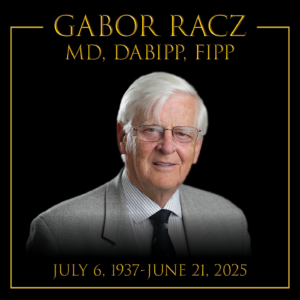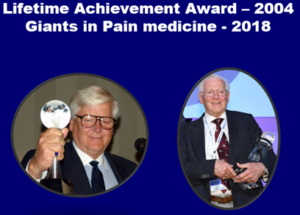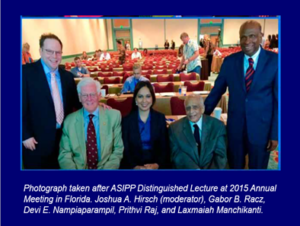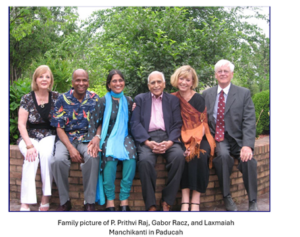
It is with profound sadness and a deep sense of loss that we share the passing of our beloved teacher, mentor, friend, and colleague, Gabor Bela Racz, MD, who passed away peacefully in his sleep in the early hours of June 21, 2025. Widely recognized as a Giant in pain management worldwide and awarded by the American Society of Interventional Pain Physicians (ASIPP) with this award, Dr. Racz’s contributions shaped the very foundation of our field.
Though he earned global acclaim, many of us remember him best as the long-serving Professor and Chair of Anesthesiology in Lubbock, Texas, where he trained hundreds of fellows and countless other physicians. He was an innovator at heart, pushing the boundaries of interventional pain medicine with vision and precision. I recall, even as early as 1982 when I began my anesthesiology practice, Dr. Racz had already pioneered the use of a spring, shear-resistant catheter to perform epidural injections in patients with epidural fibrosis—an innovation inspired by the kinking of an intravenous catheter in a pregnant patient. This eventually became the percutaneous epidural neuroplasty, known worldwide as the “Racz Procedure”, now performed hundreds of thousands of times across the globe.
His pioneering work extended beyond catheters and techniques. He applied this same catheter for intrathecal phenol injections for cancer pain and later combined it with hypertonic saline for adhesiolysis, further refining and standardizing these procedures.
Dr. Racz’s educational impact was equally far-reaching. Together with Dr. Prithvi Raj, he co-founded the World Institute of Pain (WIP), and the Annual Gabor Racz Pain Conference in Budapest stands as a testament to his enduring legacy.
He consistently emphasized that every procedure must be SAFE (safe, appropriate, fiscally responsible, and effective), he advanced multiple interventional techniques for both cancer and non-cancer pain, including early work in neuromodulation. Despite his towering influence across continents, it is humbling to remember that he began his life in Budapest (born 1937), fleeing Hungary during the 1956 Revolution with his beloved wife Enid, and later making the United States his home. He raised a loving family and found joy in the company of his children and grandchildren.
On a personal note, I first met Dr. Racz during a breakfast meeting—an encounter that led me to begin performing adhesiolysis. When I once faced a complication with a retained catheter, he personally guided me through the resolution. He had a gift for recognizing and encouraging original thinkers, and I was honored to receive the Trailblazer Award from him through WIP. I cherish the photographs from his visit to Paducah, KY, where he and Enid spent time with us, along with Drs. Prithvi and Susan Raj. These moments and memories hang proudly in my home and office.
Dr. Racz will be remembered not only for his unparalleled contributions to pain medicine but also for his compassion, mentorship, and enduring humanity. His absence leaves a void that will not be easily filled—but his legacy will live on through every life he touched and every procedure he refined.
While we miss him sorely, this is the time we can memorialize him. If you are interested in writing about him, please submit the manuscripts to Pain Physician. You will be waived the submitting fee.
Limits are as follows:
Abstract: Up to 250 words
Text: Maximum of 3,000 words
You can use pictures, references, etc. which are outside the limits.
Laxmaiah Manchikanti, MD
Chairman of the Board and Chief Executive Officer, ASIPP




Following Memoriam Provided by Standiford Helm, MD
Gabor Bela Racz, MD passed away peacefully in his sleep in the early hours of June 21, 2025. With his passing, we have lost one of the great figures of interventional pain management.
Dr. Racz was born and raised in Budapest. He left Budapest in the turbulent days of the 1956 Hungarian revolution with his wife of sixty-four years. One can still see the chip created in the building by a bullet intended for him.
Dr. Racz was able to make his way to England, where he completed his medical education and played on the English national water polo team. He was able to emigrate to the United States, where he started his academic career at Syracuse, NY. In 1977, he moved to Texas Tech, where he developed and ultimately led the pain program.
Dr. Racz’s academic career was characterized by ceaseless efforts to improve and innovate. A few weeks before his passing, his conversation focused on potential medical innovations and areas for new research. As early as 1976, he pioneered the use of spring-wound, shear-resistant catheter. Initially, this catheter was used to aid in the proper intrathecal placement of phenol for cancer. Coupling this development with an appreciation of the use of hypertonic saline, it was a short step to the creation of the percutaneous adhesiolysis procedure, whose shorthand name is the Racz procedure, done with a Racz catheter.
Dr. Racz’s educational efforts continued on an international scale. He was instrumental in developing the World Institute of Pain, which will be holding the 28th Annual Gabor Racz Pain Conference later this year.
Dr. Racz believed in the three pillars of interventional pain management, efficacy, safety, and patient access. He was always focused on how to change procedural techniques to avoid complications. The blunt needles whose use he pioneered changed the risk profile of arterial impingement.
Gabor Racz’s passion was his belief that no one should live in pain. He believed in his patients and was determined to support and heal them. He was more than a physician; he was their hero.
He said, “Treat your patient as if they were your own mother.”
